many retail stores. Today Argentine is a well paved city with excellent water and lighting systems, street railway, good public school system, many churches, good hotels and is an extensive banking town. The population in 1910 was 6,500.
Argonia, one of the incorporated towns of Sumner county, is in Dixon township, on the Chikaskia river and at the junction of the Atchison, Topeka & Santa Fe and Missouri Pacific railways, 20 miles west of Wellington, the county seat. It has an international money order postoffice, from which emanate four rural routes, express and telegraph offices, telephone connection, grain elevators, a good school system, and is the principal shipping and supply point for the western part of the county. Several religious demoninations, including the Baptists, Methodists, Friends and Presbyterians, are represented by neat houses of worship. The population in 1910 was 466.
Arickaree, Battle of.—This action terminated the Indian wars on the plains. It was the most tragic of the many battles fought with the Indians in Kansas and Nebraska and took its name from the place where the battle which was fought—on a small island in the middle of the Arickaree, a branch of the Republican river. This island is now included in the state of Colorado, near the west line of what is now Cheyenne county, Kan.

BEECHER'S ISLAND. SEPT. 17. 1905.
In the summer of 1868 a troop of renegade Indians, composed of men from several tribes, made a raid on the settlers of the Saline and Solomon valleys, killed a number of people, drove off numerous horses and captured two white women, one of whom lived on White Rock creek, Jewell county, the other on the Solomon river in Ottawa county. Most of the settlers from the district fled to the towns for safety. The Indians were well armed and mounted and moved rapidly toward the north. Many of the settlers along the Saline and Solomon were old soldiers and quickly formed an armed band to pursue the Indians but could not
